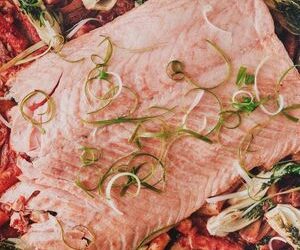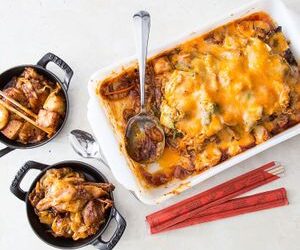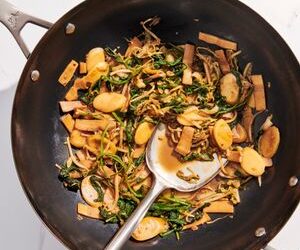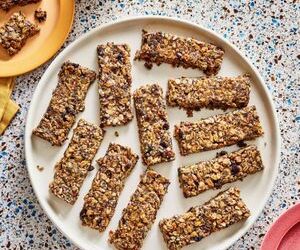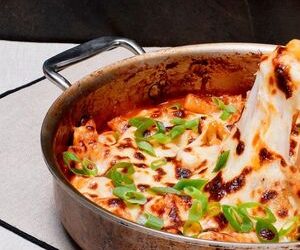Tteokguk, a Korean rice cake soup, is a must-have for the first day of the Lunar New Year, called Seollal. Chewy oval rice cakes are simmered in a light beef broth and topped with shredded brisket, thin ribbons of egg omelet, fragrant scallions, and roasted seaweed. It’s a comforting dish to welcome in the new year.
While the beef broth may take up to two hours to simmer, it doesn’t require much attention. The remaining elements are quick and easy to put together. If you make the broth ahead of time, it’s an easy meal to assemble.
Koreans eat this soup for any meal, breakfast, lunch, or dinner. It is often served with banchan, like a side of kimchi.
Symbolism of Tteokguk
Tteokguk, always served on Seollal, is full of symbolism. The oval shape of the rice cakes symbolizes coins for prosperity. They are cut from long ropes of rice cakes—its length represents long life. The white color symbolizes purity and the fresh start of a new year.
Eating a bowl of this rice cake soup marks the passing of a year. Despite the heavy mantle of symbolism, at heart, this soup is a humble dish.
Simply Recipes / Uyen Luu
How to Make Korean Rice Cake Soup
A light broth is made by simmering beef brisket with onions, garlic, and scallions until the meat is very tender. It is then seasoned with soup soy sauce (more on this below) and salt.
The brisket is shredded and seasoned with garlic, sesame oil, salt, and pepper. Right before serving the soup, the rice cakes are briefly simmered in the broth until softened but still chewy.
The soup is then garnished with the seasoned brisket, julienned egg omelet, chopped scallions, and thin strips of roasted seasoned seaweed.
Ingredients for Rice Cake Soup
I cook Korean food on a semi-regular basis, so I stock up on ingredients when I go to the Korean market. I buy a couple of bags of fresh rice cakes to store in my freezer. The soup soy sauce will last forever in your pantry and even longer in the fridge.
-
Rice cakes: Rice cakes, called tteok or dduk, can be found in the refrigerated or frozen foods section of well-stocked Asian markets. Be sure to buy the oval-shaped rice cakes and not the stubby cylindrical ones.
Frozen rice cakes should be soaked in cold water for about 20 minutes before adding them to the broth. Note that if soaked for too long, they may begin to crack. If the refrigerated ones aren’t pliable, you’ll want to give them a soak too.
You may be able to find fresh rice cakes, sold loosely packed in plastic bags in the fresh prepared food section at well-stocked Korean markets–there’s no need to soak these. Dried versions exist and can be bought online but they’re usually not great quality.
-
Roasted seasoned seaweed: These are the same ones you often find in small packets at the supermarket, labeled as roasted seaweed snacks. In Korean markets, they’re sold in similar small packets or as larger sheets, the same size as the nori sheets used to make sushi. If purchasing the large sheets, be sure they are the roasted variety.
I prefer the smaller packets because they’re single-portioned—no need to worry about the unused portion getting stale. You can thinly slice the seaweed into 1/8-inch strips with a sharp knife on a cutting board or cut them directly over the bowl of soup with a pair of scissors. There’s no need to be fussy and exact. You can even tear or crush the seaweed with your hands.
-
Soup Soy Sauce: Soup soy sauce, guk ganjang, is the residual liquid from making doenjang, a fermented soybean paste. It is a Korean soy sauce that is used in soups in lieu of regular soy sauce, which is also widely used in other Korean dishes. Soup soy sauce is lighter in color, saltier, and has more umami than regular soy sauce.
Too much soup soy sauce will darken the broth, so for this recipe I use 1 tablespoon of it and add salt to season. Look for it in Korean markets and store it in the refrigerator or at room temperature. In a pinch, you can use a little less regular soy sauce.
Simply Recipes / Uyen Luu
Substitutions
My version uses more beef and eggs and less rice cakes than what I see served in Korean restaurants; feel free to bulk it up with more rice cakes if you’d like. Here are other ways to make it:
-
Use beef bone broth instead of beef broth. Ready-made bone broth can be purchased at well-stocked Korean markets and some Korean restaurants. They should be clear or milky in color. Don’t use boxed or canned beef bone broth or beef stock since they often contain vegetables, herbs, and spices that will not work for this soup.
-
Beef chuck roast can be used instead of the brisket.
Add-Ons and Variations
Here are some classic add-ons and variations to try:
- Koreans often add mandu, Korean dumplings, to the soup. It’s then called tteok mandu guk.
- For a quicker weeknight meal, make the broth with dried anchovies and dried kelp (also called kombu) simmered in water and then strained. Sauté strips of flank steak or ground beef with soy sauce, garlic, sesame oil, and sugar for garnish instead of the shredded brisket.
- Instead of the thinly sliced omelet, you could slowly stream the beaten eggs into the boiling soup, a technique you may have seen to make egg drop soup.
Simply Recipes / Uyen Luu
How to Store and Reheat the Soup
It’s best to store the soup, the rice cakes, and the garnishes separately. The rice cakes will get mushy and lose their appealing chew if they sit in the soup for too long. Enjoy any leftovers within three or four days.
To reheat, bring the soup to a boil and cook fresh rice cakes in it.
More Warming Soups to Try
Hawaiian Oxtail Soup
Tom Yum Soup (Spicy Thai Soup with Shrimp)
Albondigas Soup (Mexican Meatball Soup)
Easy Tuscan Bean Soup
Colombian Chicken Soup
